by Jacob Zhicheng Zhang // June 24, 2022
Informed by a biography that bespeaks binary tension—imagine dividing thirty years of your life between crawling in Manhattan and schooling well-to-do students in rural Maine—Pope.L, working with the curator Dieter Roelstraete, opens his first solo exhibition, ‘Between a Figure and a Letter,’ in the darkened octagonal basement of Berlin’s Schinkel Pavillon. Most visitors to the exhibition are likely anticipating the installation located in the sunlit hall two floors above which is, on the arrival of an audience, activated by a dramatically loud performance. Curiosity thus permeates the bifurcated space as one wonders what the acutely sarcastic critic of contemporary culture has drawn up or, rather, torn down for Berlin.
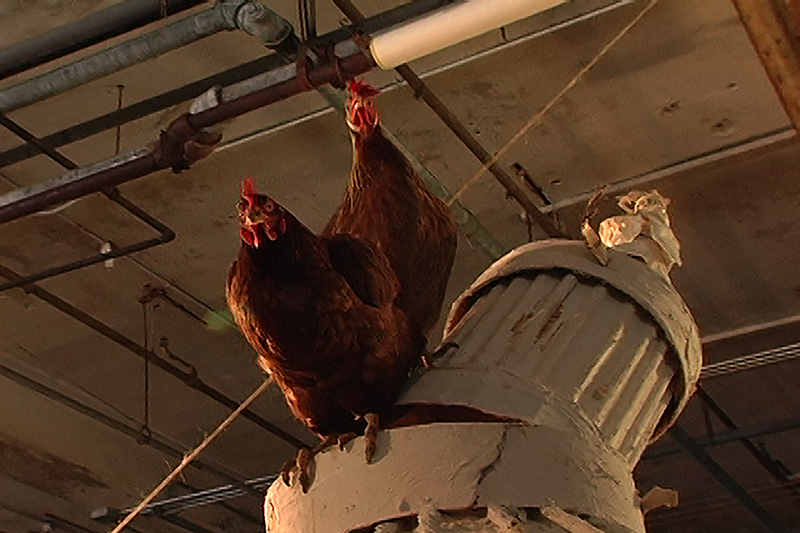
Pope.L: ‘Small Cup,’ 2008, video still // Courtesy of the artist
The video ‘Small Cup’ (2008) begins with an astoundingly thunderous blast. In the projection one witnesses the outside and inside of a derelict textile mill in Maine—one site of many that dot the numerous rivers in the state. Soon, chickens and goats enter the scene, rummaging chaotically for feed inside the building. Only later can one make out that the feed covers an architectural model resembling the U.S. Capitol. The cupola, which stems back to the ancient Greek meaning the titular “small cup,” is the main structural feature of both the Capitol and its model. The fact that this symbol of a federal republic is being toppled and eaten away marks an obvious provocation. As Roelstraete has rightfully maintained in the text accompanying the exhibition, the work seems to prophetically announce the events of January 6, 2021, when over 2000 supporters of Donald Trump entered the Capitol by force. But it also exudes a deeper distrust of these systems, especially considering that the work was produced somewhat anticlimactically in 2008, a year visually distinguished by the proliferation of Shepard Fairey’s iconic Barack Obama “Hope” poster.
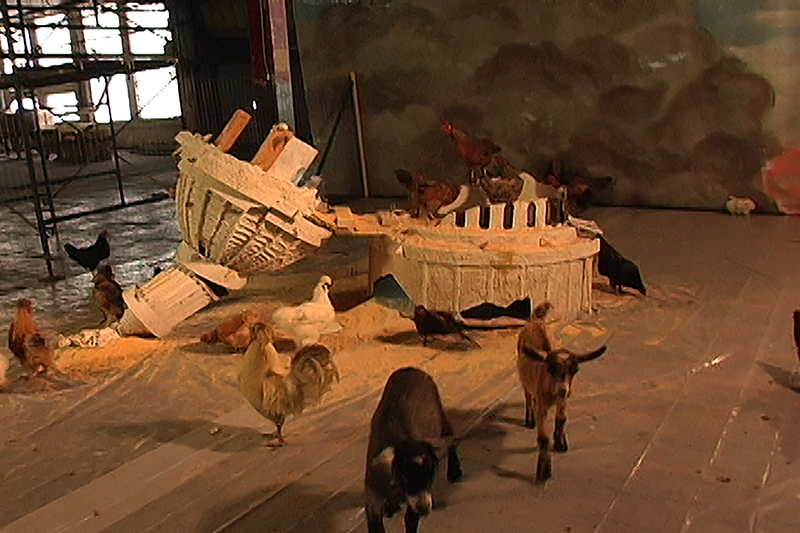
Pope.L: ‘Small Cup,’ 2008, video still // Courtesy of the artist
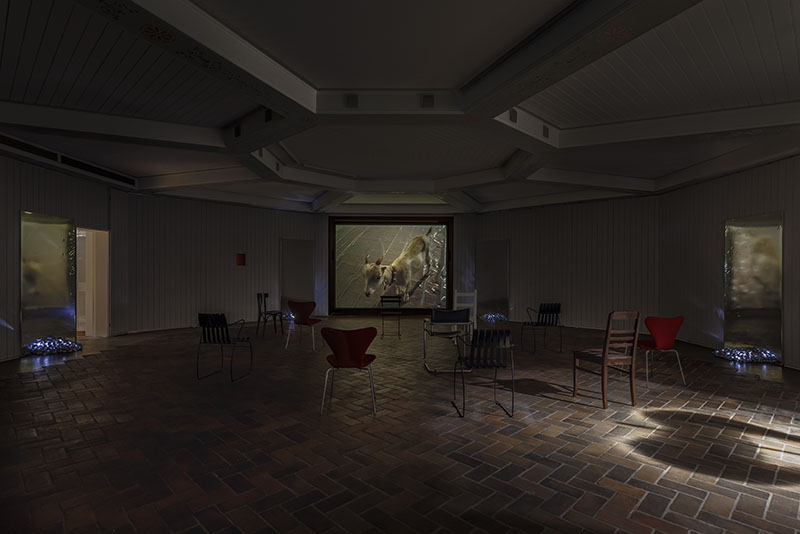
Pope.L: ‘Between A Figure and A Letter,’ exhibition view, Schinkel Pavillon, Berlin, 2022 // Courtesy of the artist and Schinkel Pavillon, Photo by Frank Sperling
The video is flanked by several rectangular, door-shaped stretchers covered with a foil-like material, which, upon closer inspection, can be seen to produce a mirror-like reflection. The foil is marked by subtle undulations that, when combined with single-source lighting, somehow allow the objects to cast impossible-looking shadows. Adding to the uncanny mood, piles of already sprouting potatoes, previously painted a silver-gray color, glow next to the shadows. Signs of plant life are both muffled and enhanced several times through the artist’s silvery interventions.
Viewers are forced to consider the assemblages alongside the ‘Skin Set Drawings’ (2011–13), which are also scattered throughout the basement. These small works on paper zoom in on the spaces between (supposedly meaningful but now severed) Latin letters—letters that belong to a short story titled ‘Forlesen’ (1974) written by science fiction writer Gene Wolfe. The story is about a man named Emanuel Forlesen, who spends his days in a corporate world filled with papers and subdivisions, not unlike what one could observe in a Lumon Industries set in the hit television series ‘Severance’ (2022). Institutions of the (near) present thus make surrealistic appearances in the work of Pope.L. They might come through via slightly opaque associations, but rarely can their presence be refuted. They function similarly to the broken letters and tainted in-between spaces that cast doubt on meanings supposedly rendered stable by written texts.
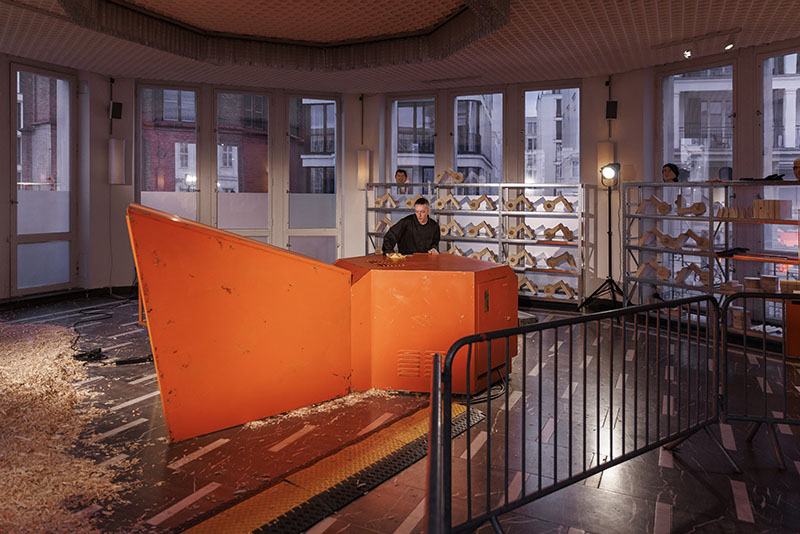
Pope.L: ‘Contraption,’ 2022, Schinkel Pavillon. Performer: Mickey Mahar // Photo by Frank Sperling
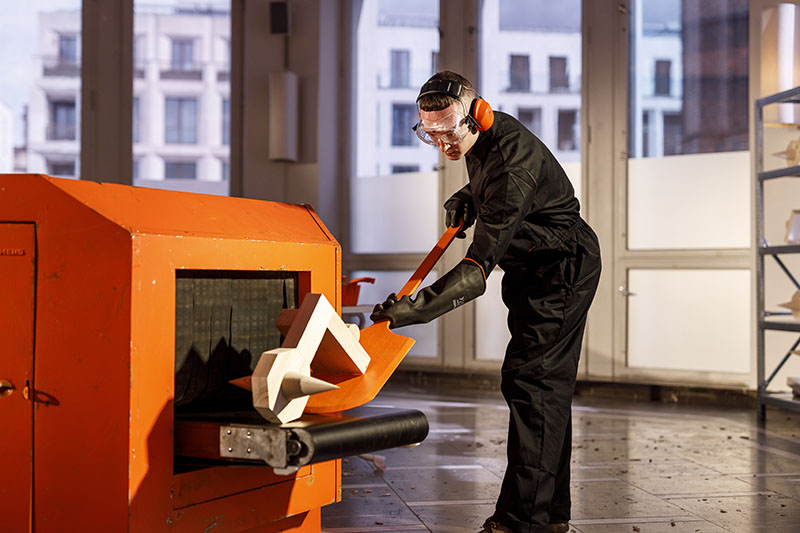
Pope.L: ‘Contraption,’ 2022, Schinkel Pavillon. Performer: Mickey Mahar // Photo by Frank Sperling
It could be said that the exhibition, along with its allusions to the government-corporate affinities, culminates in the installation-performance ‘Contraption’ (2022) on the upper floor. In a number of clearly delineated steps and full of a sort of mechanistic fervor, the performer carries out his bizarre task. Wooden models that combine the architectural features of the Humboldt Forum and the Schinkel Pavillon are periodically fed into the apparatus at the center of the installation—a woodchipper remodeled to appear as a giant, alluring, orange machine. Despite the many steps that lead to the process of feeding the wood through the machine, as well as the booming noise that drowns out conversation, the woodchipper’s spurting of chips only lasts about a second. As soon as the chips are no longer ejected onto a large mechanical drawing facing the machine, the performer winds down—in a disciplined manner—by calmly answering a ringing phone and lovingly wiping away wood dust from the centerpiece, only to later repeat this ritual all over again.
Cupolas of religious, political and cultural significance adorn the nineteenth-century structures and their contemporary replicas in this stately Berlin district, making the Schinkel Pavillon the ideal location for alternatively rehearsing metonyms and metaphors of power and control. The resulting works, each absurd on its own terms, are smirks in the face of the order and commitment that is fostered and curated by political, cultural and economic institutions. They target the propriety and structure perceived by us viewers when we enter art institutions to experience art. They make us aware of not only the grandiose monumentality of the institutions and objects they reference, but also, and most importantly, their destined futility.
Exhibition Info
Schinkel Pavillon
Pope.L: ‘Between A Figure and A Letter’
Exhibition: Apr. 9–July 31, 2022
Admission: € 6 (reduced € 4)
schinkelpavillon.de
Oberwallstraße 32, 10117 Berlin click here for map
























